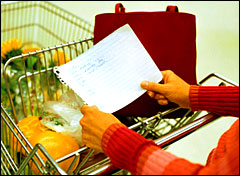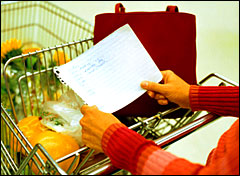There’s something about Thanksgiving that seems to prompt people to think about where their food comes from. Maybe it’s all the cornucopias and sheaves of wheat depicted in supermarket circulars, or maybe it’s the focus on the harvest. Visions of farmers bringing in the crops may lead people to think about how food gets to their table, and whether it would make sense, or even make a difference, to try to buy organic food for the holiday meal. The Grist editors asked me to create a Thanksgiving menu and compare the costs of using organic ingredients versus using conventional ones.

It’s all in the list.
Most of us know there are important reasons to buy organic food: protecting one’s health and the health of one’s friends and family is key, of course. It’s also better for the environment (including water sources) if there is less demand for produce grown with pesticides and fertilizer, and it’s better for farmers and farm workers not to have to encounter these chemicals as they go about the work of feeding us.
“Sure, I’d buy organic if I could,” I hear you sighing, “but it’s so expensive!” That’s true, to an extent: the organic products I surveyed generally cost more, but the difference was a lot less per serving than most people assume. (The exceptions were animal products: organic turkey and dairy items cost substantially more than their conventional versions, and they cost a greater percentage more than organic versions of produce compared to conventional produce.) Also, in many cases organic prices seem high because organic farmers don’t receive the same kind of government support that industrial farmers do, so the prices of “regular” items are, in reality, artificially low.
After wandering the aisles of a Whole Foods and a mainstream supermarket, my head was spinning. I wanted to be able to submit this article with a sweeping conclusion, giving a tidy total for the cost of each type of meal. But as in life, nothing is quite that simple — there are lots of variables when it comes to food shopping, and decisions each shopper must make. Still, I have a few tips for prioritizing organic purchases that can help make any meal a little better.
The Menu
Here’s the Thanksgiving menu I devised. I would start off with an arugula salad made with sliced pears, shaved asiago cheese, and balsamic dressing. Next I would serve turkey with a dressing made with packaged bread cubes, celery, carrots, and onion. I would, of course, serve it with gravy, and I’d make a fresh orange-cranberry relish to serve with the turkey and to use in turkey sandwiches afterwards in case there are leftovers. Yum! (I can’t believe I’m salivating at the idea of imaginary leftovers. That’s just sad.)
As for starches, there would be mashed potatoes — a moment of silence, please, for my late father’s mashed potatoes, which, in all honesty, were merely a conveyance for shocking amounts of butter and cream and perfectly seasoned with trace amounts of salt and white pepper — and my Great Aunt Karlie’s bourbon-intensive sweet potato pudding. Sigh.
I like to serve lots of vegetables, so there will be green beans tossed with lemon butter and a bit of freshly ground black pepper, carrot coins served with butter and marjoram, and creamed spinach with just a little bit of nutmeg in the cream sauce.
For dessert I will serve apple pie with a wedge of cheddar cheese on the side, and coffee.
So, how much will my imaginary meal cost?
I got prices for organic and conventional items from the Whole Foods in Woburn, Mass., and a large, mainstream supermarket in Cambridge that I visited with my intern, Anna, a few days later. Here’s a tip: if you want to get someone to help you in a large store, just walk around looking curious and holding a notebook and pen. Concerned staff people will mysteriously appear at your side!
The Shopping
Many of the products were not sold in easily comparable amounts, such as “stalks” (meaning whole heads) of celery vs. a per-pound price for cut celery ribs; also, sometimes we couldn’t find perfect matches to compare, so we used something like organic French fingerling potatoes from Whole Foods to compare to the supermarket’s only organic potatoes, Yukon, or a conventional frozen turkey compared with a fresh organic one. When it comes time to do your own shopping, you’ll have to rely on your common sense.

Be thankful for a low-pesticide meal.
One helpful way to prioritize produce purchases is to use the Environmental Working Group’s list of pesticide-laden fruits and veggies. I’ve noted each fruit and veggie’s ranking below; the lower the number, the higher the pesticide residue, and the higher you should prioritize buying the organic version.
I’ve listed all the prices I found, for all you economics majors and inveterate shoppers out there. The key for the prices is as follows:
WFO = organic at Whole Foods
WFC = conventional at Whole Foods
SMO = organic at the supermarket
SMC = conventional at the supermarket
1. Arugula salad
By my best estimate, it would cost about twice as much to make an organic version of this salad, but considering how high lettuce and pears rank on the list of pesticide-laden produce, I think it’s worth it. The trick, at least according to my shopping experience, may be finding organic pears, especially in winter. Consider substituting an in-season fruit like organic apples instead.
Pears (#10 on the EWG list): WFO: Bosc, $2.99/lb., D’Anjou, $2.99/lb.; WFC: Bosc, $1.99/lb., Bartlett, $1.79/lb.; SMO: none; SMC: Chilean Bosc, $1.99/lb., California Bartlett, $1.69/lb.
2. Turkey with gravy and orange-cranberry relish
I wasn’t able to compare a fresh organic turkey to a fresh, non-organic turkey, so these birds aren’t entirely on even footing, but the fresh organic cost more than twice as much per pound as the frozen non-organic. This would probably be the biggest price leap in a Thanksgiving meal. Here’s one good reason to spend the extra money if you can: non-organic turkeys are fed antibiotics, which can reduce resistance to antibiotics in people who eat the meat*.
Stuffing mix: WFO: $2.49 for 10 oz.; WFC: $5.99/lb. for in-house bread cubes; SMO: none; SMC: $3.19/16 oz.
Yellow onions (#45 on the EWG list): WFO: $1.99/lb.; WFC: $.99/lb.; SMO: none; SMC: $1.49/lb.
Celery (#4): WFO: one “stalk” (i.e., the whole head), $2.49; WFC: one “stalk,” $1.99; SMO: $4.58/lb.; SMC: $0.99/lb (one pound bag).
Carrots (#13): WFO: loose carrots, $0.99/lb.; WFC: $0.99/lb., SMO: $1.19/lb.; SMC: $0.99/lb.
Cranberries (not on EWG list): WFO: none; WFC: $2.49/12 oz., SMO: $3.29/7 oz. (7.52/lb.); SMC: $2.69/12 oz. ($3.59/lb.); SMC: dried cranberries, $4.29/10 oz.
Citrus (oranges #19, tangerines #22): WFO: $1.99/lb. for Valencia juice; WFC: clementines, $1.99/lb., navel oranges, $1.99/lb.; SMO: Valencia oranges (4), $3.99/22 oz.
3. Starches
Taking another look at the EWG produce list, we see that potatoes rank fairly high — but happily, there are organic varieties available that cost the same as, or even less than, conventional ones. Make this a must-buy on your organic list.
Potatoes (#12): WFO: Organic French fingerling potatoes, $4.99/24 oz.; WFC: russet and red, $1.29/lb., yellow, $1.49/lb.; SMO: Yukon, $4.49/4 lb. bag ($1.12/lb.); SMC: russet, $2.69/5 lb. bag (53.8 cents/lb.), red, $2.99/5 lb. bag (59.8 cents/lb.), yellow, $1.49/lb.
4. Mmm, veggies
Spinach (#11): WFO: loose baby spinach, $7.99/lb., Earthbound packaged baby spinach, $5.99/lb.; WFC: no fresh beans, $1.99/10 oz. for frozen, in-house brand and $2.69/lb. for another brand.
5. Apple pie with cheese, coffee
Since apples are No. 2 on the pesticide list, make sure to shell out a little more for organic if they’re part of your plans. And if you’re making a pie, spring for all-organic ingredients — after all, what’s the point of using chemical-free apples if your butter is full of hormones?
Cheddar Cheese: WFO: raw sharp cheddar (aged a minimum of 8 months), $5.99/8 oz., raw milk (aged 60 days), $4.99/8 oz.; WFC: Cabot Hunter’s, $7.99/lb.; SMO: none; SMC: Cabot Hunter’s, $7.49/lb.
Coffee: WFO: Jim’s Organic Vienna Roast, $10.00/12 oz., WFC: Rao’s Espresso Viennese, $8.99/12 oz.
5. Miscellaneous
Ah, that wonderful Thanksgiving category of miscellaneous. Here I file pomegranates, which I’ll use for a centerpiece (I couldn’t find any organic ones, unfortunately); dairy products; and pantry items like flour and sugar.
Heavy cream: WFO: $3.29/pint; WFC: $2.99/pint; SMO: none, SMC: $2.79/pint.
Eggs: WFO: extra large, $4.39/dozen, large, $3.99/dozen; WFC: extra large, $2.59/dozen, large $2.49/dozen; SMO: extra large, $2.99/6 eggs, SMC: extra large, $1.79/dozen, large, $1.69/dozen.
Butter: WFO: salted, $5.29/lb.; WFC: salted, $2.69/lb.; SMO: none; SMC: no-rBGH, $4.29/lb., sweet cream salted, $2.59/lb.
Sugar: WFO: $2.99/lb.; WFC: $1.99/lb.
Flour: WFO: $3.29/5 lbs.; WFC: $2.39/5 lbs.
Olive Oil: WFO: Italian, $12.99 for 33.8 fl.oz.; WFC: Spanish, Greek, or Italian, $7.99/33.8 fl. oz.
I’m still crunching the numbers for my meal plan (and dreaming about those leftovers), but in the meantime, here are a few tips for your budget:
- If you can’t afford to buy everything organic, prioritize those pesticide-laden pieces of produce.
- To stretch your dollars further, consider axing one item from your menu — do you really need mashed potatoes and sweet potatoes? The money you save on sweet potatoes could go into organic potatoes.
- If you can’t find an organic version of something you want, don’t panic or run all over town trying to find it. Instead, buy the conventional, and write a letter or send an email to your supermarket to encourage them to stock more variety.
And above all else: don’t wait until Wednesday night to do your shopping! Buy everything except perishables before Wednesday — then you can get the few last items you need and check out via the express line.
Happy cooking — happy eating — and happy Thanksgiving.


